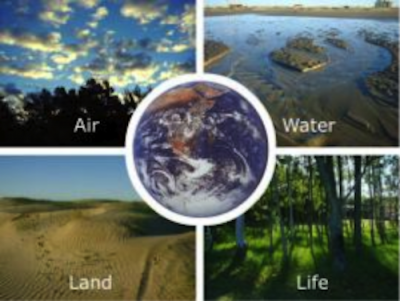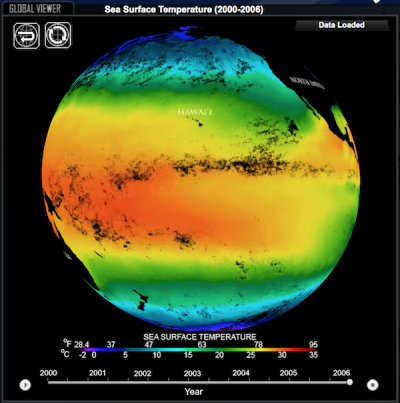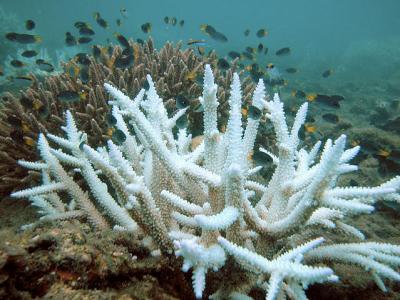Understanding Sea Level Rise
Clarification Statement: Examples could include the influence of the ocean on ecosystems, landform shape, and climate; the influence of the atmosphere on landforms and ecosystems through weather and climate; and the influence of mountain ranges on winds and clouds in the atmosphere. The geosphere, hydrosphere, atmosphere, and biosphere are each a system.
Assessment Boundary: Assessment is limited to the interactions of two systems at a time.
This activity builds on the content below to help students understand how the atmosphere interacts with the hydrosphere.
Earth's Systems
Fig. 1. EarthвҖҷs systems (geosphere, hydrosphere, atmosphere, and biosphere) are dynamic; they interact and react to changing influences, including human activities.
Image courtesy of NASA Global Precipitation Measurement Mission (GPM)
EarthвҖҷs surface is a complex and dynamic set of interconnected systemsвҖ”the geosphere, hydrosphere, atmosphere, and biosphere (Fig. 1)вҖ”that interact over a wide range of temporal and spatial scales. Weather and climate are shaped by the complex interactions of the ocean, the atmosphere, sunlight, clouds, ice, land, and life forms. EarthвҖҷs biosphere has changed the makeup of the geosphere, hydrosphere, and atmosphere over geological time. Geologic events and conditions have also affected the evolution of life on Earth. Components of EarthвҖҷs systems may remain relatively stable, change slowly, or change abruptly, with significant consequences for living organisms. Changes in one system can cause further changes to that system or to other systemsвҖ”often in surprising and complex ways. This topic explores how humans have contributed to the influence of the atmosphere on landforms and ecosystems through weather and climate.
Weather and Climate
Weather is all around us and has a profound influence on our day-to-day lives. Weather affects how and where we live, what we do each day, what we wear, and what we eat. Weather describes the day-to-day conditions of the atmosphere at a particular location. While weather varies from day-to-day at any particular location, over the years, the same type of weather patterns generally re-occur. This recurring weather pattern is known as climateвҖ”the average weather conditions in a particular place over a long period of time.
Climate Change
Climate change is a broad term that describes the changing of environmental conditions throughout the EarthвҖҷs history. Changes in climate can result from natural events, such as volcanic eruptions, changes in the EarthвҖҷs orbit, or changes in the amount of energy released from the sun. Human activities also affect the chemical composition of the atmosphere and influence the EarthвҖҷs climate.
The predicted effects of current climate change vary by location and, as a result, climate change will have different effects on humans and ecosystemsвҖ”depending on their location on the planet. In general, scientists belonging to the International Panel on Climate Change (IPCC) conclude that global climate change is expected to lead to the following changes of our EarthвҖҷs weather and climate patterns over the next century:
Fig. 2. A snap shot of Sea Surface Temperatures (SST) in 2006. For an interactive exploration of SST change from 2000-2006, follow the NOAA link below. (Note: Flash required to run animation.)
Image courtesy of NOAA
- increased air and sea temperatures (Fig. 2)
- rises in sea level
- changes in weather patterns
- more frequent storms
- droughts
- floods
- other extreme weather in some places
- changes in the seawater chemistry due to increased carbon dioxide concentrations
A Warming Atmosphere
Since the start of the Industrial Revolution in the 1700's, humans have been drastically increasing the amount of gases, like carbon dioxide (CO2), in the atmosphere by burning fossil fuels and deforesting (removing trees and green plants). The most significant climate change in modern times is the warming of our Earth. EarthвҖҷs temperature has increased by 0.7в„ғ (1.3в„ү) over theвҖЁ last 100 years. The naturally occurring gasses in the atmosphere act as a greenhouseвҖ”trapping heat energy from the sun, which gives them the name greenhouse gasses. Greenhouse gases are actually very important to making Earth a habitable place to live. Without the blanket of greenhouse gases in the atmosphere, Earth would be, on average, about 15в„ғ (60в„ү) cooler, making our climate much colder.
Fig. 3. This diagram shows how the greenhouse effect of the atmosphere influencing our weather and climate.
Image courtesy of the Myron B. MBTA (MBTA) curriculum from SOEST
Sea Level Changes
With increases in CO2, evidence of EarthвҖҷs warming can be found worldwide. In particular, many of the worldвҖҷs glaciers are retreating, melting, or shrinkingвҖ”not only in area but also in thickness. In Alaska, an average of 1.8 m (6 ft) of glacier thickness is being lost each year. This is more than twice the annual rate observed from the 1950s to the mid-1990s. Sea level is also risingвҖ”over the last hundred years, sea level has increased an average of 15 cm (7 in.). Melting glaciers account for some sea level rise. Warming ocean temperatures also contribute to higher sea level because water volume expands as water warms (assuming that pressure stays the same).
Climate Change Impact in Hawai'i
The most immediate change threatening HawaiвҖҳi and other Pacific Islands will no doubt be a result of sea level rise. Recent IPCC projections are for a sea-level rise of 48 cm (about 1.5 feet) by 2100. Globally, 100,000,000 people live within approximately 1 m (3.3 feet) of present day sea level, including most of HawaiвҖҳiвҖҷs population. Rise in sea-surface temperatures (SST) will also contribute to complications. Some effects of sea level rise and warming are:
-
Image caption
Fig. 4. Coral bleaching is a stress response to high temperatures. These two corals from the Great Barrier Reef in Australia exhibit different responses; with the front looking fully bleached and the back healthy.
Image copyright and sourceImage courtesy of Wikimedia Commons
Increases in intensity and frequency of storm surges,
- Increased coastal erosion resulting in loss of land and livelihood from tourism,
- loss of important wetlands and mangroves,
- Reduced availability of fresh water due to seawater intrusion into HawaiвҖҳiвҖҷs coastal freshwater aquifers
- Rise in SST are redicted to be 1.4вҖ“5.8В°C (2.7-7.7В°F)
- Coral bleaching
- Impacts on fisheries as reefs decline and influence other species of fish that depend on the reef
| Sea Level Rise Viewers |
|
Use these web mapping tools to visualize community-level impacts from coastal flooding or sea level rise (up to 10 feet above average high tides). Photo simulations of how future flooding might impact local landmarks are also provided, as well as data related to water depth, connectivity, flood frequency, socio-economic vulnerability, wetland loss and migration, and mapping confidence. HawaiК»i Sea Level Rise Viewer (You can zoom in to specific areas across HawaiК»i) |
Sea Level Rise Vocabulary
|













